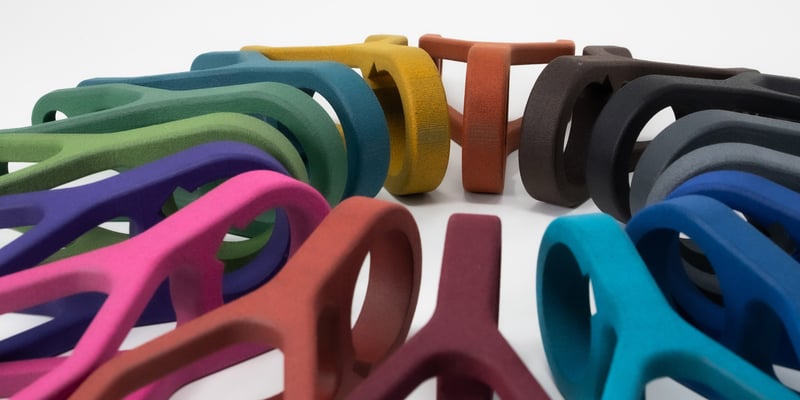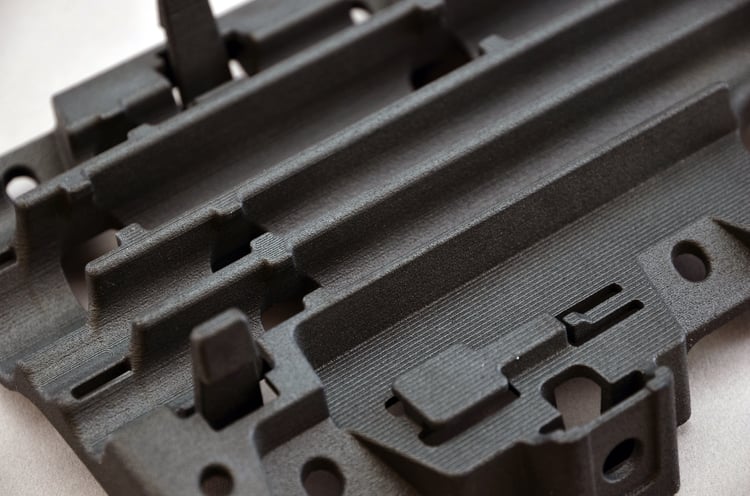SLS 3D Printing: Materials Used
-
By
Marie-Christine Flibotte
August 23 2023
-
Tech tips and tutorials

Cost optimization, improved productivity, high definition printing, great freedom of design… these are some of the advantages of SLS 3D printing (selective laser sintering). With its laser sintering printing offer, Solaxis has chosen to specialize in polyamide 11 and its derivatives, in order to provide a distinctive and competitive offering compared to the market This opens the door to the production of various types of parts, regardless of the sector of activity. Discover the properties of the materials that can be used for SLS 3D printing and start planning the production of your next parts!
Advanced Materials for Various Applications
Although many materials can be used for designing parts with SLS 3D printing, all have a common characteristic: they are easily shaped. Through systematization, the use of the following thermoplastics makes it possible to print parts with complex geometries, in a reproducible manner, whether it is about designing a prototype or answering production challenges. Here are some examples of our materials:
Nylon PA 11
Nylon PA 11, a popular thermoplastic for short and medium series due to its excellent mechanical properties, makes it possible to design parts manufactured by SLS 3D printing with the following specificities:
- Robust and durable
- Significant ductility
- High impact resistance
- High elongation at break (45%)
- Excellent chemical resistance
- Biobased (castor oil)
- Biocompatibility
Nylon PA 11 is therefore recommended for the design of critical parts, that is those frequently subjected to significant physical stresses. It is available in white and black, and can be dyed if needed. We prefer this material for the SLS 3D printing of medical equipment, automotive parts, medical orthotics, or various components used in the defence and security sector. This thermoplastic is effective for functional prototypes, replacement parts, and low-volume production that can be subjected to average loads.

Nylon PA 11 CF (carbon-filled)
Loaded with carbon fiber, Nylon PA 11 CF gives SLS-printed parts exceptional mechanical properties:
- Tensile strength: for example, while the tensile strength is 28 MPa for polypropylene, 45 MPa for PA 11, it is 71 MPa for Nylon PA 11 CF.
- Heat deflection temperature under load of 189 °C at 0.45 MPa versus 176 °C for PA 11 and 102 °C for polypropylene under similar conditions.
- Excellent impact resistance
- High elongation
- Excellent strength/weight ratio
- Biobased (castor oil)
Nylon PA 11 CF is an excellent material for manufacturing parts that must present outstanding rigidity and solidity. Among others, we take advantage of the properties of this thermoplastic when it comes to designing automobile parts, light structure components, replacement parts for metal components, partially electrically conductive parts using SLS additive manufacturing.
Nylon PA 11 ESD
Although Nylon PA 11 ESD obviously has characteristics similar to Nylon PA 11 (high tensile strength, important elongation), it also stands out for its specific properties such as low electrical resistivity and resistance to electrostatic discharge.
Thus, this thermoplastic offers a multitude of possibilities for the electronics sector. To this end, we have also completed various mandates focused on SLS 3D printing of electronic casings. ESD-safe materials, such as PA 11 ESD, are mainly used in electronics manufacturing, where thousands of electronic components are produced every day, requiring various components, jigs, tooling and custom fixtures.
Polypropylene
A common thermoplastic used in injection molding, polypropylene is also a material of choice for SLS 3D printing. In fact, it stands out for its characteristics:
- Excellent chemical resistance
- Relatively high ductility
- High rigidity
- High elongation at break (about 30%)
- Low moisture absorption
- Relatively low cost
Thanks to its properties, polypropylene is a great material for manufacturing parts such as tools or industrial equipment, ventilation ducts or containers dedicated to the storage of various products, especially chemicals. This material works perfectly for hinges and clips, economical and functional prototypes.
At Solaxis, we print various parts in polypropylene, especially for the healthcare, electronics, automotive, and specialized transport sectors.
SLS 3D printing allows the use of many materials with various characteristics. The manufactured parts can therefore meet mechanical, physical and/or aesthetic requirements as well. As a result, SLS 3D printing finds its place in different sectors of activity.
You want to produce parts using SLS 3D printing, but you don't know which material to use? Ask our experts for advice. Contact us!


